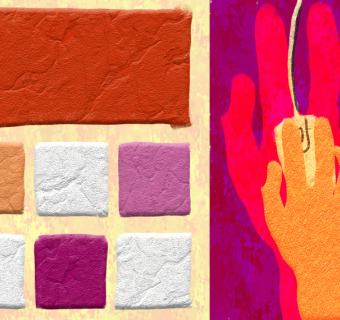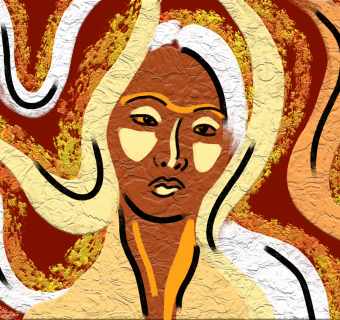I love weddings, but I didn’t always.
When I was younger, they left me sitting with my hands over my ears in family photos. I hated the loud music, the pulsing rhythms of dholak beats and voices which seemed to leave all the bones in my body with a slight tremor. I hated the mad crush of people, crammed wall-to-wall in old family houses which are no longer in the family, having been sold or rented or abandoned to America.
These days, there always seems to be another wedding around the corner. My weekends have been overrun with bridal showers, girls’ dance parties and group texts filled with image after image of generously embellished silk, organza and lace. When my cousins and I are together, the air is suffused with the unease of never knowing who might be next. I’m forced to consider my mortality as I stand against yet another photo booth wall, as I eat yet another bakery cupcake and drink oversweet tea from styrofoam cups--the choice intoxicant of good Muslim families.
Weddings occupy an odd, transitional space in South Asian communities, in and out of the diaspora. They can be sacred or irreverent, modern or traditional. The couple might be fresh out of high school/college/medical school, or they might be well into their spinster-thirties.
The grooms remind me of an assembly line product, with their gelled hair and neatly lined-up beards. Most of them have red, inflamed complexions, having exfoliated for the first time just the day before. The best grooms are the ones who go the extra mile, the ones with manicured hands and lightly made up faces. The ones who force laughter at the bridesmaids’ unimaginative wedding-night jokes.
The brides are always beautiful, sometimes in red and sometimes not. Their makeup seems to get thicker every year, perhaps to cover the effect of many sleepless nights spent fine-tuning a couple-name-hashtag, the bedrock of any wedding worth its salt. Their necks are encircled with gold and kundan and diamonds, their arms weighted with rows of bangles. My grandmother used to tell me that a married woman carried her wealth on her body like armor, that all she had in the world was the gold in her nose and ears.
Like the brides themselves, weddings come in all sizes. The can be average, meaning a few hundred family members and a biryani dinner at the Hyatt, a by-the-hour Rolls. They might be big, meaning average, only at a Hilton instead of a Hyatt.
Of course, the undisputed crowd-pleaser is the weshouldbringbacktheguillotine, showstopper, badshah-opulent wedding. These maharajah matrimonials clock in at least at a thousand guests. You can distinguish them from the weddings of the masses by the Instagram wall of fresh flowers and the requisite appearance of Sabyasachi couture, by the choreographed dance performance in which the groom’s sister contorts her body like a caged snake. The bride’s parents might sing along to the pounding music, looking depleted. These types of weddings are soaked and cured in money, six or seven figures of it. It oozes from the corners of the Dubai ballroom or Scottish castle rented for the occasion. Appearance by a drama or film star is optional, but not really, because did you even get married if Fawad Khan wasn’t there to see it?
I wish I were joking, really. But I’ve been to some of these weddings. And although they are always entertaining, they have a coppery aftertaste, like swallowing pennies. Something about them feels insincere--I have a hard time believing any little girl wants to walk down an aisle to the booming voice of an MMA-style emcee.
For most of history, in both the East and the West, a wife was just another asset, like a plot of fertile land or particularly industrious workhorse. The first weddings were cut-and-dry financial transactions--people weren’t shy about the money that had changed hands to get them to the altar. Romance wasn’t added to the equation until much later, and for a while, the whole institution was repackaged and rebranded as a celebration of love, of a union between individuals.
And I believe in that love. I see it every day, in the way my cousins’ faces light up when their partners call or text. I see it in the companionable silence of my grandparents, who were married for seventy years.
And yet, the weddings I attend seem to be moving closer to their mercenary, medieval origins. With every passing year, they get more outrageous, engorged with excess. There is something vulgar about seeing money plastered on the walls and the bodies of women.
It makes me wonder how we could be so quick to allow the hyper-consumerism of the West to become a global import, a new age of imperialism.
For most people my age, in my community, weddings are a link to the past, a moment of cultural expression that, for the most part, has survived the process of becoming American. They remind us that we belong to a tradition that traverses oceans and centuries. One of the most beautiful things about South Asian weddings is how they celebrate brownness, even proclaim brownness, without apology. My favorite part of any wedding is the generational portrait that fills the photographer’s lens, the disorganized jumble of parents and grandparents and younger siblings surrounding the bride and groom. A sea of grinning faces. The glimmer of gold on silk. The cousin whose eyes are always stubbornly closed in the photo (in my family, it’s me). And as I get older, these materialist matrimonials have become a fact of my life, popping up every few months as my friends and cousins keep finding themselves suddenly coupled.
Like I said, I love weddings. But I am skeptical of what some of them have become. And I don’t have any definitive answers on how best to target the wedding-industrial complex, but I think a good start might be to think about the difference between what weddings are and what they are meant to be. Hollywood tells us that a wedding is a deep, instinctive secret to human connectivity. And although that might be just another myth, sending subliminal messages to our minds and telling us to buy and consume more, a part of me wishes that the myth was true. There is something comforting about a fairy tale, even one that doesn’t end the way you want it to. And that is what the desi wedding is in its purest form. It’s a fairy tale, part of a longer legacy of brown people in the West who, on their big days, exist for the first time in front of the state and God. I like to think that we’ll always be around, and that someday, we’ll be able to get this wedding thing right. Someday.







